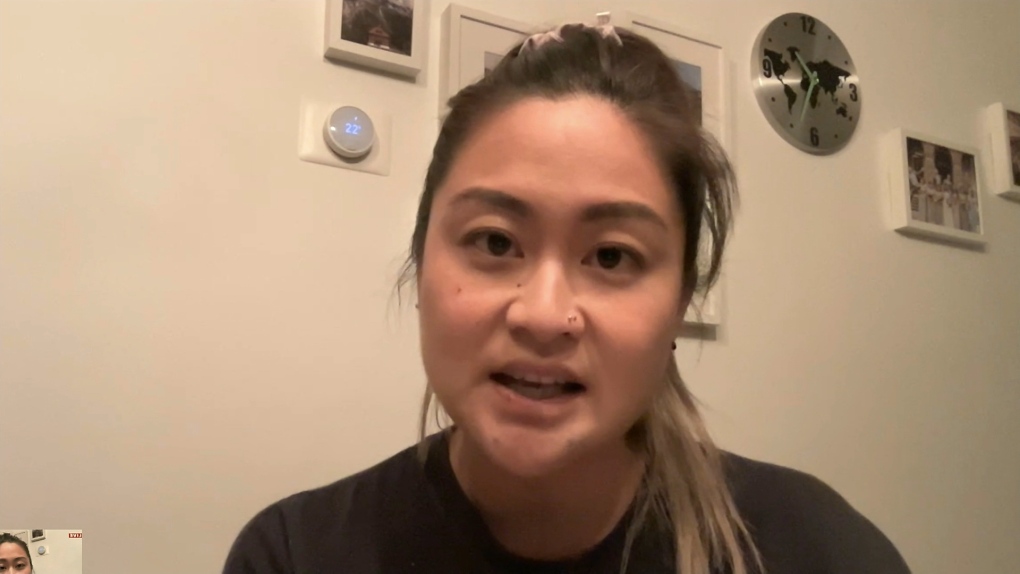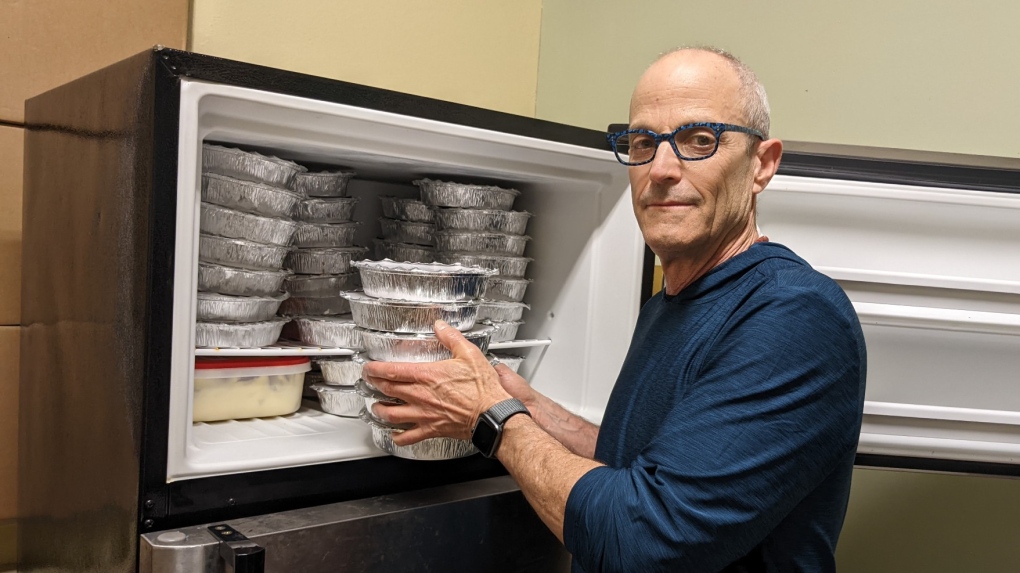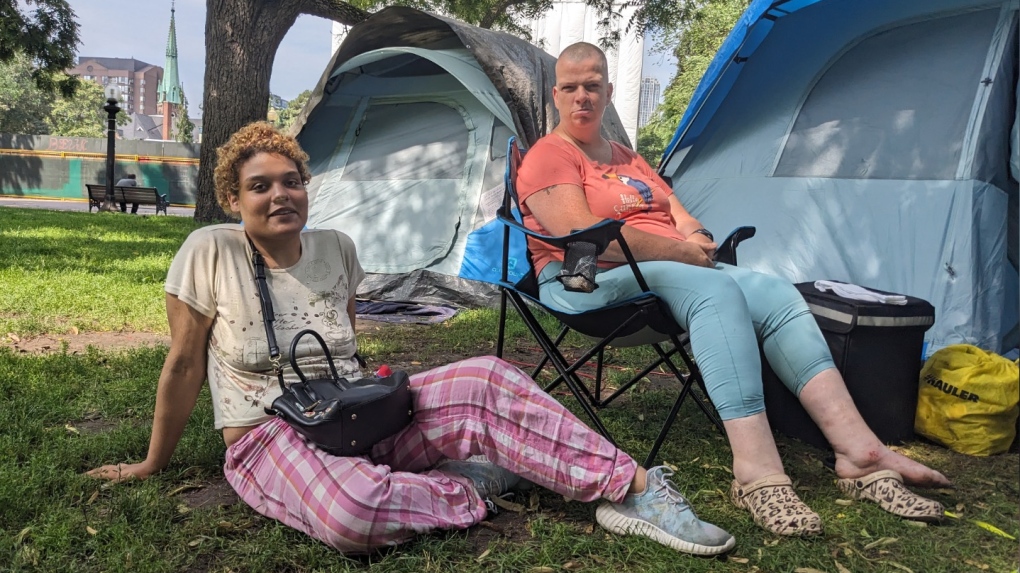
'Beyond an emergency': Toronto's unhoused population grappling with extreme heat, bad air quality
On Day 3 of Toronto’s first heat wave of the summer, people living in tents at Allan Gardens faced 40-degree temps and polluted air that smelled like a campfire.
“I actually have been fainting and passing out in my tent,” said Penelope Starks, who has been camping at the downtown east park for about a week since she left a shelter.
“Sometimes I feel dizzy and it’s hard to breathe.”
An asthmatic who also has sleep apnea, Starks said sometimes she can go into a store to get a break from the extreme heat and smoky air, which last week was among the worst in the world.
Others staying at the local greenspace bounded by Gerrard, Carlton, Sherbourne, and Jarvis streets aren’t so lucky.
Encampment resident Kimberly, who did not wish to give her last name, recently fractured her ankle and is struggling to get around. Without TTC fare, she’s pretty much stuck at Allan Gardens to weather the elements.
“I’ve been basically sleeping, laying down a lot,” shared Kimberly, who told CP24.com that she has asthma and suffers from epileptic seizures.
“Between the bad air and the heat, I’ve been feeling very tired.”
Starks said many of the people staying at Allan Gardens have health and mobility issues, and are basically left to fend for themselves. She pointed to one woman at the park who recently became overwhelmed, and suffered a heat stroke and had to go to the hospital.
“On the days when it’s really bad, people cannot breathe at all. … People are coughing up stuff,” she said.
When Environment Canada issues a heat warning, the City of Toronto responds by evoking its Heat Relief Strategy, which “provides a framework for the implementation and coordination of hot weather response activities focused on reducing the negative health impacts of extreme heat.”
This year from May 15 to September 30, Toronto will be opening 550 publicly accessible libraries, community centres, and civic centres, as well as private and non-profit facilities like shopping malls and YMCA locations for people to cool down during the extreme heat.
The city’s heat relief strategy also includes street outreach, extending the operating hours of pools, and public messaging and education, as well as emergency shelters, drop-ins, and 24-hour respite sites for those experiencing homelessness.
This plan, however, does not include emergency cooling centres, which in past years have opened at accessible locations throughout the city for vulnerable people during periods of high heat and humidity.
Kimberly of the Allan Gardens encampment said it’s “stupid” that the city opens warming centres in the winter, but doesn’t do the same in the summer “when the side effects are just as bad.”

Long-time outreach worker Lorraine Lam agreed.
“It seems that it’s not a priority to open cooling centres like in the winter, but the effects of the heat can be just as bad,” she said, adding concrete action must also be taken now to help vulnerable people in the city who are impacted by the smoky air.
Lam said city officials need to have the same conversations about supporting people experiencing homelessness in the summer as they do during the winter months.
During an interview with CP24.com, she said the city’s heat relief plan is “missing a whole segment of the population,” adding it doesn’t make sense to expect unhoused individuals to show up at public pools to beat the heat as many of the people she supports may not even have a bathing suit and admittedly wouldn’t be made to feel welcome at such facilities.
Lam also noted that many of the city’s public cooling spaces are only open during the day, but the heat and bad air often persists well into the evening hours.
 Rafi Aaron, the co-coordinator of St. Luke's Out of the Cold meal program, loads some prepared meals into a freezer at the downtown east church.
Rafi Aaron, the co-coordinator of St. Luke's Out of the Cold meal program, loads some prepared meals into a freezer at the downtown east church.
Rafi Aaron, the spokesperson for the Interfaith Coalition to Fight Homelessness, called the situation unhoused people are facing in this city “beyond an emergency.”
“What we need are all-year extreme weather centres,” said Aaron, who is the co-founder of a twice-weekly community meal program in the downtown east area.
A long-time advocate, Aaron has also spearheaded a grassroots effort called Waves of Compassion, which since July 2020, which has distributed 235,000 bottles of water to vulnerable people in Toronto.
“(Toronto’s heat relief strategy) is a fiction when it comes to unhoused individuals. It’s inaccessible and inadequate,” he said, adding the city needs to bring water trailers to encampments and other places where unhoused people gather, and open more washrooms in parks.
“This is negligence that’s causing great suffering. … Keeping people outside in this weather is just inhumane.”
Currently, there are 182 washrooms in parks and more than 700 drinking water fountains. More than 150 community recreation centres with washrooms are also open to the public.
Aaron also said that the unprecedented number of people being refused a bed each night at the city’s shelters is causing great strife among Toronto’s unhoused population. According to the latest data from May, Central Intake turned away, on average, 220 people daily.
The City of Toronto is not disputing the fact that it is facing some significant challenges.
“(We continue) to offer a number of services to help individuals experiencing homelessness; however, the shelter system is strained and unable to meet the daily increasing demand for shelter space,” spokesperson Anthony Toderian said.
“The City’s shelter system is currently accommodating approximately 9,000 people nightly. Despite adding more than 1,000 new shelter spaces in the last year, the system is strained and remains at capacity most nights. Simply put, the City is unable to meet the daily increasing demand for shelter space.”
Toderian also noted that while the city “recognizes the need for additional services to help meet the complex needs of those living outdoors during heat warnings, (it) continues to face significant financial pressures.”
“The City needs the federal government to provide promised COVID-19 pandemic support of $235 million for the City’s 2022 Budget to match the Province’s commitment,” he wrote.
“The Government of Canada has not provided funding that was promised largely for pandemic transit and homelessness costs. Without federal support, City funding for future frontline services will continue to be affected.”
Street nurse and anti-poverty advocate Cathy Crowe recently penned a letter to Toronto officials and allies, including the city’s Medical Officer of Health, Dr. Eileen de Villa, which calls for more to be done to mitigate the impacts of poor air quality on unhoused and poorly housed people in Toronto.
“This is a historic and frightening situation with incredibly serious health outcomes,” wrote Crowe, who said she expected that the provincial and federal governments would have already provided recommendations and funding to address this issue.
Crowe went on to note that people experiencing homelessness, as well as vulnerable individuals staying at places with poor air quality should have “welcoming, supportive, clean air” venues to go to, places where there’s food, activities to pass the time, and staff, including a nurse or physician.
Late last week, the Toronto Board of Health considered her letter and voted to ask the de Villa to develop a Wildfire Smoke Response Strategy, which a city spokesperson told CP24.com would be “released over the coming days.”
 Penelope Starks, left, and Kimberly sit outside a tent at the Allen Gardens encampment on July 6. (Joanna Lavoie/CP24)
Penelope Starks, left, and Kimberly sit outside a tent at the Allen Gardens encampment on July 6. (Joanna Lavoie/CP24)
CTVNews.ca Top Stories

Smith tells Trudeau Alberta will opt out of federal dental plan
Alberta is opting out of the federal dental plan, the premier told the Canadian government late Tuesday afternoon.
One of Canada's most popular vehicles recalled over transmission issue; 95,000 impacted
One of the country's most popular vehicles is being recalled in Canada due to a transmission issue that may impact tens of thousands of drivers.
WikiLeaks' Assange pleads guilty in deal with U.S. that secures his freedom, ends legal fight
WikiLeaks founder Julian Assange pleaded guilty to a single felony charge for obtaining and publishing U.S. military secrets in a deal with Justice Department prosecutors that secures his liberty and concludes a drawn-out legal saga that raised divisive questions about press freedom and national security.
'We need to regroup,' says Liberal minister and Ontario campaign co-chair in light of byelection loss
A member of Prime Minister Justin Trudeau's cabinet and the party's Ontario co-chair for the next campaign says the Liberals 'need to regroup' after a shocking overnight byelection loss to Pierre Poilievre's Conservatives.
Pre-med students can't take MCAT in Quebec because of Bill 96
Areeba Ahmed says she's always dreamed of becoming a surgeon but her road to the operating room has become a complicated one ever since Quebec's French language law came into effect.
'Truly a great British Columbian': Former B.C. premier John Horgan has cancer again
Former B.C. premier and current Canadian ambassador to Germany John Horgan has been diagnosed with cancer for a third time.
Canada beats Peru 1-0 at Copa America on David goal, first win over South American team in 24 years
Jonathan David scored in the 74th minute, and Canada beat Peru 1-0 on Tuesday night in the Copa America for its first victory over a South American opponent in 24 years.
Cup Noodles serves up notoriously poisonous pufferfish
Pufferfish is regarded as a luxury in Japan and a meal featuring the potentially poisonous delicacy can easily cost up to 20,000 yen (US$125) at high-end restaurants.
Electric vehicle infrastructure lags in Prairie provinces
The Prairies, along with Newfoundland and Labrador, trail the rest of the country in electric vehicle (EV) infrastructure.































